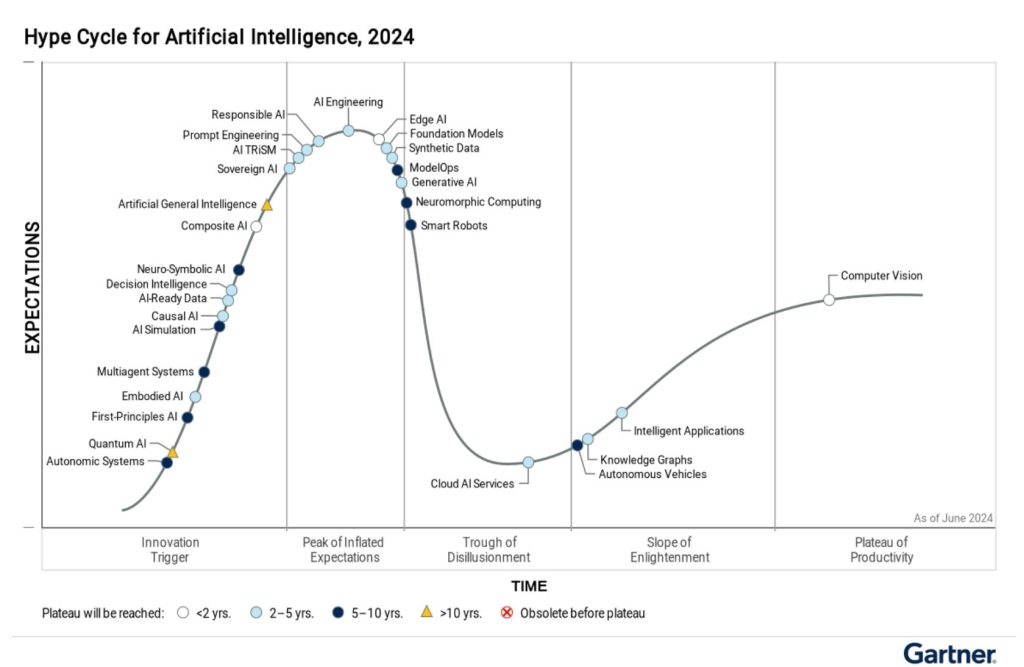Understanding the AI Hype Cycle can be crucial for business leaders aiming to stay competitive in today’s fast-evolving technological landscape. The Hype Cycle for Artificial Intelligence in 2024, as depicted by Gartner, offers a clear view of where various AI technologies stand in their journey towards maturity and productivity. Let’s walk through this cycle and explore how it impacts businesses and what steps you can take to ensure your organization remains ahead of the curve.

The Journey Through the Hype Cycle
The Hype Cycle starts with the Innovation Trigger. Here, we see groundbreaking technologies like Quantum AI and Autonomic Systems making their debut. These innovations spark interest and excitement, much like the buzz around the first smartphones. For example, Quantum AI holds immense potential for solving complex problems at unprecedented speeds. However, these technologies are still in their infancy, and practical applications might be years away. Business leaders should watch these developments closely, keeping an eye on early trials and pilot projects.
Moving along, we reach the Peak of Inflated Expectations. This phase is characterized by hype and lofty promises. Think of AI Engineering and Responsible AI, which are currently generating a lot of buzz. It’s similar to the early days of the internet boom, where everyone expected immediate transformative impacts. Businesses need to be cautious here. While investing in these technologies can be tempting, it’s essential to manage expectations and prepare for a reality where not every innovation will deliver instant results.
As we descend into the Trough of Disillusionment, the excitement fades, and reality sets in. Technologies like Generative AI, Neuromorphic Computing, and Smart Robots are in this phase now. This is where many early adopters face challenges. Imagine the initial hurdles faced by companies investing in early autonomous vehicles – frequent glitches and unmet promises. However, this phase is also where perseverance pays off. Continued investment in research and development can eventually lead to breakthroughs. For instance, businesses can use this time to refine AI models, gather more data, and improve algorithms.
Climbing out of the trough, we enter the Slope of Enlightenment. Technologies here start proving their value and finding practical applications. Intelligent Applications and Autonomous Vehicles are examples currently on this slope. Think about the evolution of electric cars – from being a niche product to becoming mainstream. For businesses, this is the sweet spot for investing in AI. These technologies have shown they can deliver results, and further improvements and cost reductions are on the horizon.
Finally, we reach the Plateau of Productivity, where technologies become widely adopted and stable. Computer Vision is at this stage now, much like how smartphones are ubiquitous today. Business leaders can confidently invest in these technologies, knowing they are reliable and can provide tangible benefits.
How Does This Impact Your Business?
Understanding where different AI technologies stand on this cycle helps businesses make informed decisions about their AI investments. For instance, if you’re in the retail sector, Computer Vision can enhance inventory management and improve customer experience through advanced image recognition systems. On the other hand, an insurance company might look into AI Engineering to streamline claims processing and risk assessment.
Consider a scenario where a healthcare provider is exploring AI for diagnostic purposes. Investing in technologies at the Peak of Inflated Expectations might seem risky, but partnering with tech firms and universities for pilot projects could yield significant long-term benefits. Alternatively, focusing on technologies in the Slope of Enlightenment, such as Autonomous Vehicles for patient transport, can offer more immediate and reliable improvements to service delivery.
Steps to Stay Competitive
- Stay Informed and Educated: Regularly update yourself and your team on the latest advancements in AI. Attend industry conferences, subscribe to relevant journals, and participate in webinars. Knowledge is power, and being well-informed allows you to make better strategic decisions.
- Adopt a Balanced Investment Strategy: Diversify your AI investments. Allocate resources to a mix of technologies across different stages of the hype cycle. This approach minimizes risk and maximizes potential gains. For example, while investing in the promising but nascent Quantum AI, also consider proven solutions like Computer Vision for immediate benefits.
- Collaborate and Network: Forge partnerships with AI startups, academic institutions, and industry consortia. Collaborative efforts can drive innovation and provide access to cutting-edge research and development. For instance, collaborating with a university on an AI research project could give you early access to groundbreaking technologies and top talent.
- Align AI Initiatives with Business Goals: Ensure that your AI strategy aligns with your broader business objectives. Technologies should be adopted not just for their novelty but for their ability to solve specific business problems. For instance, using AI to enhance customer service should directly contribute to improving customer satisfaction and retention.
- Implement Continuous Monitoring and Evaluation: Regularly assess the performance and impact of AI technologies. Establish clear metrics to evaluate their return on investment and operational efficiency. This data-driven approach helps you make informed decisions about scaling up, pivoting, or discontinuing specific AI initiatives.
By understanding the AI Hype Cycle and strategically navigating through it, business leaders can position their organizations for sustained success. Embrace the potential of AI while being mindful of its evolving nature, and you will be well-equipped to drive innovation and maintain a competitive edge in your industry.
